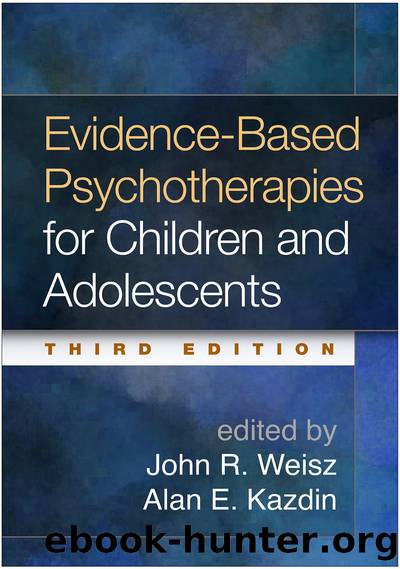Evidence-Based Psychotherapies for Children and Adolescents, Third Edition by John R. Weisz & Alan E. Kazdin

Author:John R. Weisz & Alan E. Kazdin [Alan E. Kazdin, John R. Weisz]
Language: eng
Format: epub
Publisher: The Guilford Press
CHAPTER 19
Behavioral Treatment for Enuresis and Encopresis
Michael W. Mellon and Arthur C. Houts
ENURESIS
OVERVIEW OF THE CLINICAL PROBLEM
Bedwetting is a problem for 5- to 12-year-old children. The prevalence at 6 years old is about 15% and declines to about 1% among 18-year-olds (Devlin, 1991; Foxman, Valdez, & Brook, 1986). Only 15 of every 100 children will “outgrow” the problem in a year (Forsythe & Redmond, 1974). Continued bedwetting leads to restricted social activities, embarrassment about a family secret, and diminished confidence. Given that a 4-month course of behavioral treatment can permanently fix the problem in about 75% of children, this treatment should be pursued once a child is 6 years old. Unfortunately, most parents do not know what to do, and many get bad advice from professionals.
Of the 7 to 10 million bedwetting children in the United States, about 85% are monosymptomatic primary enuretics (MPEs). They have no medical problems, they wet only at night, and they have never been dry for at least 6 consecutive months. MPEs are ideal candidates for behavioral treatment. All children should receive a basic physical examination and urinalysis. About 90% will have no medical complications, but no child should fail behavioral treatment due to an easily curable infection.
CONCEPTUAL MODEL GUIDING THE TREATMENT
Active Avoidance Learning and the Urine Alarm
All children start out wetting the bed, and most stop without special help. On average, children attain daytime control at 2.5 years old and nighttime control within a year after that. When a child continues regular bedwetting beyond age 4, he or she probably missed a developmental window for acquiring the responses needed to be dry at night. For practical reasons, behavioral treatment is generally not instituted until a child is at least 5 years old. Children get control either by waking up to go to the toilet or by physically inhibiting urination even during asleep. Learning either response is facilitated by the natural discomfort of a wet bed. If for any number of reasons (e.g., failure to arouse, habituating to discomfort from use of pull ups) a child repeatedly fails to respond to the aversive conditions of “nature,” the child will fail to learn the physical responses. Continued wetting, then, is a failure to learn how to be dry from naturally occurring conditions. From this perspective, MPE is caused by an interaction between genetically transmitted delays in physical development and behavioral histories that delay acquisition of active avoidance responses (e.g., pelvic floor contraction when awake or asleep) (Houts, 1991; Lovibond, 1963).
Urine alarm treatment re-creates conditions to perform an active avoidance response to inhibit urination. Urination starts with contraction of the bladder detrusor muscle, and this contraction can be stopped by actively contracting the muscles of the pelvic floor. The alarm is an aversive stimulus that produces a conditioned avoidance response of contracting the pelvic floor, along with the external sphincter of the bladder neck. This avoidance response is maintained by negative reinforcement. So long as the response is made, the child avoids having to wake and avoids the wet bed.
Download
This site does not store any files on its server. We only index and link to content provided by other sites. Please contact the content providers to delete copyright contents if any and email us, we'll remove relevant links or contents immediately.
Cecilia; Or, Memoirs of an Heiress — Volume 1 by Fanny Burney(31332)
Cecilia; Or, Memoirs of an Heiress — Volume 3 by Fanny Burney(30934)
Cecilia; Or, Memoirs of an Heiress — Volume 2 by Fanny Burney(30889)
The Great Music City by Andrea Baker(21311)
We're Going to Need More Wine by Gabrielle Union(18072)
Bombshells: Glamour Girls of a Lifetime by Sullivan Steve(13108)
Pimp by Iceberg Slim(12931)
All the Missing Girls by Megan Miranda(12747)
Fifty Shades Freed by E L James(12451)
Norse Mythology by Gaiman Neil(11883)
Talking to Strangers by Malcolm Gladwell(11876)
Crazy Rich Asians by Kevin Kwan(8349)
Mindhunter: Inside the FBI's Elite Serial Crime Unit by John E. Douglas & Mark Olshaker(7834)
The Lost Art of Listening by Michael P. Nichols(6472)
Enlightenment Now: The Case for Reason, Science, Humanism, and Progress by Steven Pinker(6405)
Bad Blood by John Carreyrou(5768)
The Four Agreements by Don Miguel Ruiz(5510)
Weapons of Math Destruction by Cathy O'Neil(5036)
We Need to Talk by Celeste Headlee(4868)
